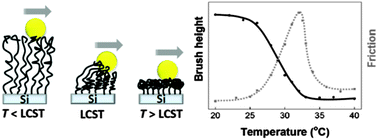Stretching of collapsed polymers causes an enhanced dissipative response of PNIPAM brushes near their LCST†
Abstract
Poly(N-isopropyl acrylamide) (PNIPAM) is a stimulus-responsive polymer that can switch in water from an expanded state below the lower critical solution temperature (LCST) of 32 °C to a globular state above the LCST. It was recently shown that, as a consequence of this conformational transition, the interfacial and (tribo-)mechanical properties of polymeric systems composed of PNIPAM can be switched between two states. Here we show that the tribo-mechanical properties of a particular type of PNIPAM system, which is the PNIPAM brush, do not just change between two states, but instead evolve continuously and non-monotonically upon increasing/decreasing temperature. To do so, we present atomic force microscopy experiments in which we measure the adhesion hysteresis and the friction upon bringing a gold colloid in relative motion with PNIPAM brushes at temperatures around the LCST. Both the friction and the adhesion hysteresis display a pronounced maximum exactly at the LCST. The force vs. distance data captured at these temperatures show a long-ranged adhesive interaction upon moving the colloid away from the original point of contact, which indicates that during this retraction the partly collapsed polymers in the brush become strongly stretched.


 Please wait while we load your content...
Please wait while we load your content...